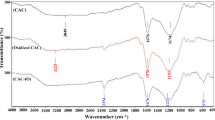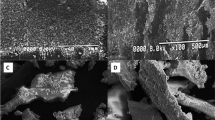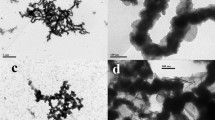Abstract
Actually, there is a growing interest in finding efficient low-cost materials that allow the removal of chemical substances from water in order to decrease the environmental impact. The use of nanoscale systems is a new area of investigation for the elimination of polluting agents from water among other useful applications in science and technology. In this work, removal of indigo blue in water solutions has been evaluated using Fe/Cu nanoparticles and composites of C/Fe–Cu nanoalloy. The first composite was using carbon obtained by pyrolysis of sewage sludge with Fe/Cu nanoparticles (MCL-NP); the second one was made with commercial activated carbon and Fe–Cu nanoparticles (CAC-NP). Synthesis of materials were carried out by the sodium borohydride reduction of FeSO4⋅7H2O and CuSO4⋅5H2O aqueous mixture. Batch adsorption and isotherm experiments were carried out in order to know the behavior of each adsorbent material employed. The experimental data were adjusted to Langmuir, Freundlich, and BET models.














Similar content being viewed by others
References
Baldrian, P., Merhautova, V., Jir, G., Nerud, F., Stopka, P., Hruby’c, M., et al. (2006). Decolorization of synthetic dyes by hydrogen peroxide with heterogeneous catalysis by mixed iron oxides. Environmental, 66, 258–264.
Bokare, A. D., Chikate, R. C., Rode, C. V., & Paknikar, K. M. (2007). Effect of surface chemistry of Fe-Ni nanoparticles on mechanistic pathways of azo dye degradation. Environmental Science and Technology, 41, 7437–7443.
Colín-Cruz, A., López-Castañares, R., Olea-Cardoso, O., Barrera-Díaz, C., & Valdez-Flores, C. (2001). Products generated from the thermal treatment of sewage sludge. Specialised conference on sludge management: regulation, treatment, utilization and disposal (pp. 164–171). Mexico: International Water Association.
Guivarch, E., Trevin, S., Líate, C., & Oturan, M. A. (2003). Degradation of azo dyes in water by electro-Fenton process. Environmental Chem Lett, 1, 38–44.
Hsieh, C., & Teng, H. (2000). Influence of mesopore volume and adsorbate size on adsorption capacities of activated carbons in aqueous solutions. Carbon, 38, 863–869.
Jia-Ming, C., & Shi-Nian, H. (1998). Study of nonlinear wave propagation theory. 1. Dye adsorption by activated carbon. Industrial and Engineering Chemistry Research, 37, 253–257.
Joo, S. H., Feitz, A. J., Sedlak, D. L., & Waite, T. D. (2005). Quantification of the oxidizing capacity of nanoparticulate zero- valent iron. Ind Environ Sci Technol, 39, 1263–1268.
Kanel, S. R., Manning, B., Charlet, L., & Choi, H. (2005). Removal of arsenic (III) from groundwater by nanoscale zero-valent iron. Ind Environ Sci Technol, 39, 1291–1298.
Kargi, F., & Ozmihci, S. (2004a). Biosorption performance of powdered activated sludge for removal of different dyestuff. Ind Enzyme and Microbial Technolog, 35, 267–271.
Kargi, F., & Ozmihci, S. (2004b). Comparison of adsorption performances of powdered activated sludge and powdered activated carbon for removal or turquoise blue dyestuff. Ind Process Biochemistry, 40, 2539–2544.
Kunwar, P. S., Mohan, D., Sinha, S., Tondon, G. S., & Gosh, D. (2003). Color removal from wastewater using low-cost activated carbon derived from agricultural waste material. Industrial and Engineering Chemistry, 42, 1965–1976.
Ma, L. M., Ding, Z. G., Gao, T. Y., Zhou, R. F., Xu, W. Y., & Liu, J. (2004). Discoloration of methylene blue and wastewater from a plant by a Fe/Cu bimetallic system. Ind Chemosphere, 55, 1207–1212.
Mc Callum, J. E. B., Madison, S. A., Sibel, A., Depinto, R. L., & Rojas, W. R. U. (2000). Analytical studies on the oxidative degradation of the reactive textile dye uniblue A. Ind Environ Sci Technol, 34, 5157–5164.
Slejko, F.L. (1985). Adsorption technology; A step–step approach to process evaluation and application. Marcel Dekker Inc.
Slokar, Y. M., & Le Marechal, A. M. (1998). Methods of decoloration of textile wastewaters. Dyes and Pigments, 37, 335–336.
Torres-Pérez, J., Solache-Rios, M., & Colín-Cruz, A. (2008). Sorption and desorption of dye remazol yellow onto a Mexican surfactant-modified clinoptilolite-rich tuff and a carbonaceous material from pyrolisis of sewage sludge. Water, Air, and Soil Pollution, 187, 303–313.
Vautier, M., Guillard, C., & Herrmann, J. M. (2001). Photocatalytic degradation of dyes in water: case study of indigo and of indigo carmine. Catalysis, 201, 46–59.
Acknowledgments
The authors are grateful to the Universidad Autónoma del Estado de México for the financial support through the research project 2342/2006 and Marcos Solache-Ríos for his suggestions.
Author information
Authors and Affiliations
Corresponding author
Rights and permissions
About this article
Cite this article
Trujillo-Reyes, J., Sánchez-Mendieta, V., Colín-Cruz, A. et al. Removal of Indigo Blue in Aqueous Solution Using Fe/Cu Nanoparticles and C/Fe–Cu Nanoalloy Composites. Water Air Soil Pollut 207, 307–317 (2010). https://doi.org/10.1007/s11270-009-0138-1
Received:
Accepted:
Published:
Issue Date:
DOI: https://doi.org/10.1007/s11270-009-0138-1




